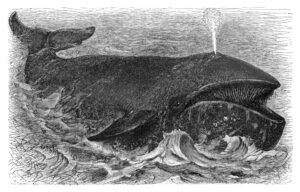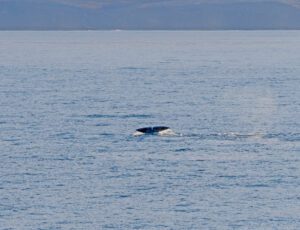
Which have we explored more: the surface of Mars or our oceans? You’d be forgiven if you said Mars; no human has ever set foot on the Red Planet whereas people visit the seas all the time. But in truth, most of the surface of Mars has been mapped, whereas only five percent of the Earth’s oceans have been explored. Fortunately, it doesn’t take much exploring to find bowhead whales- although there is a bit of a trek to get to them.
Also known as the Arctic whale or Russian whale, bowhead whales are only found in the Arctic regions. While the occasional humpbacks or grey whales make their way to such areas, the bowhead is easily identified by their iconic double hump and lack of a dorsal fin. They also have the longest baleen of any whale species, able to reach five meters in length. They’re incredibly hearty, as studies on a bowhead skull revealed they were hunted by Inuits; bowhead whales could live over 200 years, making them one of the longest-living mammals known to humankind.
Unfortunately, this longevity meant very little when faced with whalers. They were among the first targets for commercial whaling companies, and the devastating effects are still felt to this day. Of the five remaining populations of bowhead whales, only one is not listed as Vulnerable or Endangered. Some native groups still hunt them down, along with the existing threats of climate change and increased pollution.

But the surviving bowheads are worth seeking out. These all-black beauties occasionally breach and even do flipper slaps, sometimes spy-hopping (holding their heads above the water) when alone. While their diving habits are still under observation, they can break through ice up to 24 inches thick when it comes time to surface and breathe. The calves are curious and playful, messing about with objects found in their waters. They also stick close to their mothers while young, unlike some species. Bowhead whales prefer smaller groups but will form larger pods when at feeding grounds. Their main diet consists of krill and copepods.
So where would one go to find these creatures? There are a few locations close to human residencies that are lucky enough to see bowhead whales. Both Hudson Bay and the Gulf of St. Lawrence in Canada have populations. The seas between Alaska and Russia- the Bering, Chukchi, and Beaufort- also see some bowhead activity. That population has actually been rising, despite ongoing hunting, meaning there’s still hope for the species.
The fact that their numbers are so low (approximately 10,000, according to the World Wildlife Fund) despite ongoing efforts to limit whaling speaks to how disastrous the practice was at its peak. While Native Alaskans and Canadian Inuits are still allowed to hunt a limited number of bowhead whales, it’s only when populations are stable. And with habitat loss and toxins gathering in Arctic waters, they often are not. Fortunately, an effort has been made to protect them. You can help by eating only MSC certified seafood, which helps not only whales but other sea creatures as well.

Whales are well-loved animals that few want to see go extinct, but most of the attention is placed on more popular species like the humpback or sperm whale. Bowhead whales are magnificent in their own right, even if it’s unlikely to run into one at your local aquarium. So yes, keep wearing your “save the whales” t-shirts and donating to your environmental protection program of choice. Just remember that there are more to whales than belugas and Shamu wannabes*.
Follow our world of inspiration on Instagram and release the creator in you!
*Killer whales are not actual whales; rather, they are a species of dolphin.




